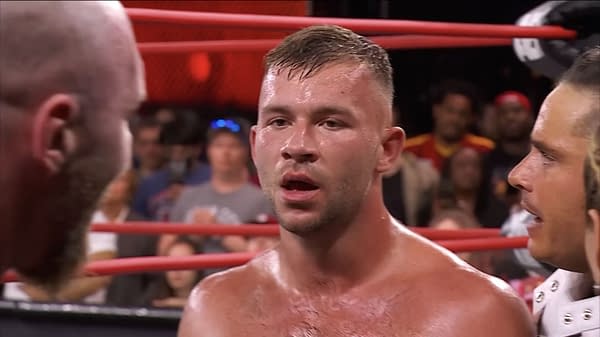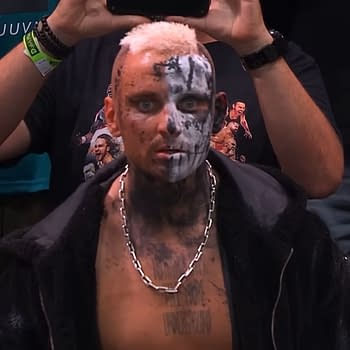Posted in: AEW, Sports, TV | Tagged: AEW Collision, recaps, wrestling
AEW Collision: Philadelphia Finale Leaves Fans Wanting More
AEW Collision concluded its 2300 Arena residency with exceptional wrestling, satisfying violence, and compelling storytelling that elevates the entire industry.
Article Summary
- AEW Collision concludes Philadelphia residency with exceptional wrestling, compelling storytelling, and character development
- Championship tournament matches showcase international talent and innovative match stipulations
- Women's division shines in high-stakes tag team bout, advancing multiple storylines simultaneously
- Main event solidifies Daniel Garcia's allegiance to Death Riders faction, ignoring pleas from former allies
All Elite Wrestling's (AEW) Saturday night offering, AEW Collision, concluded its triumphant three-week residency at Philadelphia's historic 2300 Arena with an episode that exemplified the organization's progressive approach to professional wrestling storytelling. The September 13, 2025 edition of AEW Collision demonstrated why this secondary program has become indispensable viewing for wrestling fans, presenting a sophisticated amalgamation of athletic competition and narrative development that continues to distinguish AEW from its competitors.

The evening's proceedings commenced with Mark Briscoe's pronouncement regarding his forthcoming encounter with Maxwell Jacob Friedman at All Out. Briscoe's selection of a Tables and Thumbtacks stipulation for their championship confrontation represents precisely the type of innovative match construction that AEW Collision has championed since its inception. The physicality of Briscoe's subsequent ambush, culminating in the dispersal of thumbtacks across the canvas, established immediate stakes while honoring the venue's legendary hardcore wrestling heritage.
AEW's tournament structure for the Unified Championship exemplifies the promotion's commitment to meritocratic competition. Konosuke Takeshita's victory over Anthony Bowens showcased technical proficiency rarely witnessed in contemporary wrestling. Takeshita's advancement, secured via his devastating Raging Fire maneuver, positions him alongside Kazuchika Okada in what promises to be a compelling championship confrontation at All Out. The match itself demonstrated AEW's dedication to presenting lengthy, substantive contests that allow performers to exhibit their complete repertoires.
The $500,000 ten-woman tag team encounter delivered high-octane entertainment while advancing multiple storylines simultaneously. The match incorporated the mounting tension between Kris Statlander and Jamie Hayter ahead of their championship opportunity, while the triumph of Megan Bayne and Triangle of Madness—comprised of Thekla, Julia Hart, and Skye Blue—provided financial incentive alongside competitive victory. Women's World Champion Toni Storm's commentary presence and subsequent physical involvement, culminating in her Storm Zero on Thekla, established momentum heading into her title defense at All Out.
Big Bill's dominant victory over Max Caster in the open challenge segment served dual purposes on AEW Collision. Bill's expeditious triumph, requiring merely three minutes and seven seconds to dispatch Caster with his sidewalk slam, established his credibility as a formidable competitor. More significantly, his post-match proclamation challenging Eddie Kingston for All Out in Toronto created anticipation for a clash of contrasting philosophies. Bill's derision toward Kingston's blue-collar aesthetic and Japanese wrestling influences, juxtaposed against his own imposing physical presence, promises a compelling confrontation between authenticity and perceived superiority.
The reformation narrative surrounding The Acclaimed received significant advancement through Jerry Lynn's intervention. Lynn's attempt to reconcile Max Caster and Bowens, interrupted by The Swirl's Blake Christian and Lee Johnson, created an organic scenario for potential reunion. The Philadelphia audience's explosive reaction when Bowens returned to assist his former partner illustrated AEW's capacity to generate authentic emotional responses through patient storytelling.
FTR's defensive victory against Tommy Billington and Adam Priest represented another exemplary display of tag team wrestling on AEW Collision. Dax Harwood and Cash Wheeler's systematic dismantling of their younger opponents, punctuated by their signature Spike Piledriver, reinforced their status as premier practitioners of traditional tag team wrestling within AEW's progressive framework.
Kazuchika Okada's championship retention against Michael Oku further solidified the prestige of the AEW Unified Championship on AEW Collision. Okada's methodical targeting of Oku's neck, beginning with a devastating dropkick that sent his challenger plummeting to the floor, demonstrated the champion's tactical acumen. The Rainmaker's eventual victory, secured through his signature lariat following a Tombstone Piledriver, established him as a formidable obstacle in the tournament finals. The post-match confrontation with fellow Don Callis Family member Takeshita introduced compelling questions about potential familial discord heading into All Out.
The main event encapsulated everything that makes AEW Collision essential viewing. Jon Moxley and Daniel Garcia's victory over Paragon's Kyle O'Reilly and Roderick Strong served multiple narrative purposes. Garcia's transformation, evidenced through his modified attire and ruthless in-ring demeanor, represents character evolution rarely executed with such nuance in professional wrestling. His application of the Dragontamer to secure victory, while ignoring Daddy Magic's entreaties, solidified his allegiance to the Death Riders faction.
AEW Collision continues to demonstrate why AEW has fundamentally altered professional wrestling's landscape. The program's commitment to long-form storytelling, athletic excellence, and character development provides audiences with substantive entertainment that respects their intelligence. Each segment on this edition of AEW Collision contributed meaningfully to ongoing narratives while delivering immediate satisfaction.
The strategic placement of championship tournament matches, the integration of international talent, and the careful construction of faction warfare all exemplify how AEW Collision functions as more than mere supplementary programming. Rather, it represents a crucial component of AEW's revolutionary approach to professional wrestling presentation, one that prioritizes athletic credibility while maintaining theatrical engagement.
As AEW Collision departed Philadelphia's hallowed 2300 Arena, it left behind a legacy of exceptional wrestling television that honors both tradition and innovation—precisely the balance that has established AEW as wrestling's most exciting alternative promotion.














